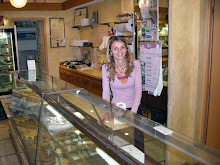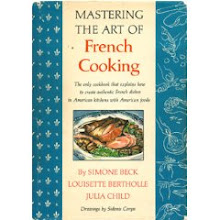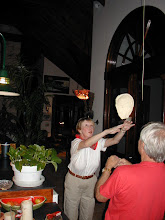La Cantina in Saint- Rémy-de-Provence quickly became one of our favorite restaurants during our recent visit to Provence. We had gotten to know and like the owners, Claude and Dana, on our trip several years ago when they owned Bistro Decouverte. Friends had told us that not long after we saw them then that they sold their very successful bistro and opened an Italian pizzeria across the street and finding them was one of our first priorities. We quickly became regulars at La Cantina and dined there for lunch or dinner at least once a week, often more. I loved it that they put VIP by our name on the reservations list.
It didn’t take long for us to realize that not only does La Cantina make the best pizza in all of Saint-Rémy, but we thought it was the best pizza we had ever tasted. Our favorite on the menu was the Pizza Margherita shown above and consists of tomato sauce, mozzarella cheese and beautiful fresh basil leaves. La Cantina’s dough is made from Italian flour and yeast, ferments for a minimum of 48 hours, then spread by hand to bring that nice crunch everyone loves to the pizza. More about their dough here on their website. Another secret to the success of their pizza is they have two new professional pizza ovens from OEM Optymo Concepts - the very first ones to be installed in France. Read more about these ovens here on La Cantina's Facebook page.
The pizza arrives at your table with a fabulous arugula salad, also called a rocket salad in France. The salad was served in a bowl family style along with a crusty baguette.
The arugula was dressed in a simple balsamic vinaigrette and topped with a very generous serving of shaved Italian Parmigiano-Reggiano cheese.
If you prefer a more substantial salad, we recommend their rocket salad accompanied by asparagus spears dressed with a creamy Parmesan cheese sauce.
La Cantina also has a nice selection of specialty salads and antipasti. We invited author and blogger Vicki Archer of French Essence to lunch at La Cantina while we were there and her favorite salad is La Cantina’s “La Grande,” shown above. It consists of rocket, cherry tomatoes, artichoke hearts, bresole, mozzarella and Parmigiano-Reggiano cheese. La Cantina is also one of Vicki’s favorite restaurants and she and her family dine there often and know Claude and Dana well.
La Cantina’s affogato was one of the best I’ve ever tasted. Affogato is one of my all time favorites and I order it every time I see it on a menu. It is an Italian coffee based beverage and makes a great ending to a rich meal. There are only 2 ingredients in an affogato – hot espresso and cold vanilla gelato. The combination of these two simple ingredients creates the most delicious cup of coffee you’ve ever had.
Claude has a rich history with wine and food and was named “Sommelier of the Year” in London in 1999. He has worked with other food greats such as Joel Robuchon and Marco Pierce White. We highly recommended that when dining at La Cantina you allow Claude to choose your wine. You will definitely not be disappointed with his choice.
The day of the running of the sheep, the Fête de la Transhumance, we arrived in Saint-Rémy very early and promptly went to La Cantina to reserve one of their outside tables by the street. Claude graciously arranged a reservation for us to sit as close to the street as possible and put a “reserved” card on our table. I'm the blonde at the middle table. You can see how close our table was to the street.
The Fête de la Transhumance in Saint-Rémy-de-Provence is without a doubt the most famous festival in the south of France. Transhumance brings back to life the day the shepherds move their sheep to the mountains for the summer. It is a traditional and moving fête dear to the hearts of the Provençal people. Read more about it here.
The sheep are marched through the center of the village and what a thrill to see. It was so exciting to sit so close to the sheep as they ran by. We were actually able to reach out a touch a couple and were surprised their coats were not as soft as they looked. I’ll have more about this festival in another post.
While the sheep and shepherds passed by right in front of our eyes, we shared La Cantina’s delicious antipasto plate. Merci beaucoup to Claude for reserving these ring side seats for us.
Whatever you do, if you are anywhere near in Saint- Rémy-de-Provence, do not miss a chance to dine at La Cantina. I can’t recommend it highly enough and I am positive that you won’t be disappointed.
La Cantina
"The best pizzeria in Provence"
"The best pizzeria in Provence"
18 Boulevard Victor Hugo
13210 Saint-Rémy-de Provence, France
04 90 90 90 60
Closed Mondays
Reservations recommended
Website & Facebook page
I know some of you are hoping for or expecting recipes. As much as I enjoy visiting with professionals about what makes their food so good, I am not comfortable asking them for their recipes. Sorry, I’m just not. But the good news is that I've tried my own versions of some of these recipes and I’ll share what I’ve found with you.
Website & Facebook page
I know some of you are hoping for or expecting recipes. As much as I enjoy visiting with professionals about what makes their food so good, I am not comfortable asking them for their recipes. Sorry, I’m just not. But the good news is that I've tried my own versions of some of these recipes and I’ll share what I’ve found with you.
I’ve made the arugula salad frequently since we’ve returned. I take handfuls of fresh baby arugula and dress it with a vinaigrette composed of 1 part best-quality aged balsamic vinegar to 3 parts extra-virgin olive oil, add a good sprinkle of French sea salt to the vinaigrette, then top the dressed salad with lots of freshly shaved Italian Parmigiano-Reggiano cheese, the best quality I could find. Claude didn’t skimp on the cheese and neither did I.
I did ask Claude about his sauce for the asparagus and he said it was just cream and Parmesan. I found several Parmesan cheese cream sauces on the web and the one here tastes similar to his. My recipe for preparing poached asparagus can be found here. We served the asparagus as an accompaniment to a steak the other night. Right before it was served I sprinkled a dusting of bright red Aleppo pepper flakes over the cream sauce to add a touch of color and a peppery flavor. It was delicious.
 |
| Photo from Bialetti's website |
Regarding the affogato, it’s a breeze to make at home, although mine never turns out as pretty as Claude’s. I did find that the espresso they serve in France was out-of-this-world fabulous and so is French gelato. I haven’t been able to duplicate either here. To make affogoto, simply brew some espresso, and for every scoop of gelato, top it with about 1 ounce of hot espresso. I use a Bialetti Moka Express pot like the one above. They’ve been making these little pots since 1933. An Italian neighbor once shared her secret espresso many years ago. Now, just like she did, before brewing my espresso I sprinkle the coffee with a pinch or two of sugar and anise seeds before I brew it to give the coffee a hint of anise flavor. For a perfect affogato, it’s best to brew your espresso just before serving it so everything is as fresh as possible. I’ve also read to chill your glass and make sure the gelato is very, very cold and I think that would keep the gelato from melting right away, which mine has the tendency to do. I don’t know what Claude’s secret was, but his gelato wasn’t melting when it was brought to the table.
For better viewing, click photos to enlarge.
This will be shared with Foodie Friday at Rattlebridge Farm and Miz Helen’s Country Kitchen Full Plate Thursday.
Have a great weekend everyone.






















































































